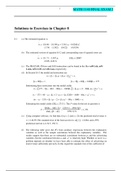Samenvatting
Summary BBS1001 - The LEGO bricks of life
- Vak
- BBS1001
- Instelling
- Maastricht University (UM)
The LEGO bricks of life (BBS1001) is first course of biomedical sciences at Maastricht University. In this document you can find everything you need to know for the exam at the end of the course. The 13 cases of the course are describe. Good luck!
[Meer zien]













